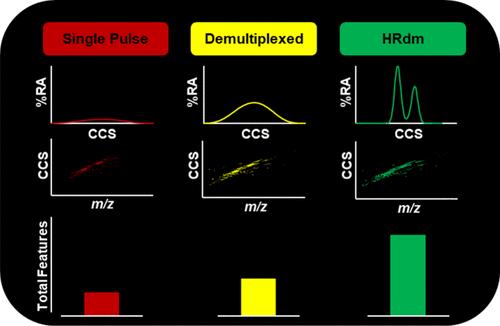An Untargeted Lipidomics Workflow Incorporating High-Resolution Demultiplexing (HRdm) Drift Tube Ion Mobility-Mass Spectrometry
IF 3.1
2区 化学
Q2 BIOCHEMICAL RESEARCH METHODS
Journal of the American Society for Mass Spectrometry
Pub Date : 2024-09-14
DOI:10.1021/jasms.4c00251
引用次数: 0
Abstract
Global discovery lipidomics can provide comprehensive chemical information toward understanding the intricacies of metabolic lipid disorders such as dyslipidemia; however, the isomeric complexity of lipid species remains an analytical challenge. Orthogonal separation strategies, such as ion mobility (IM), can be inserted into liquid chromatography-mass spectrometry (LC-MS) untargeted lipidomic workflows for additional isomer separation and high-confidence annotation, and the emergence of high-resolution ion mobility (HRIM) strategies provides marked improvements to the resolving power (Rp > 200) that can differentiate small structural differences characteristic of isomers. One such HRIM strategy, high-resolution demultiplexing (HRdm), utilizes multiplexed drift tube ion mobility spectrometry (DTIMS) with post-acquisition algorithmic deconvolution to access high IM resolutions while retaining the measurement precision inherent to the drift tube technique; however, HRdm has yet to be utilized in untargeted studies. In this manuscript, a proof-of-concept study using ATP10D dysfunctional murine models was investigated to demonstrate the utility of HRdm-incorporated untargeted lipidomic analysis pipelines. Total lipid features were found to increase by 2.5-fold with HRdm compared to demultiplexed DTIMS as a consequence of more isomeric lipids being resolved. An example lipid, PC 36:5, was found to be significantly higher in dysfunctional ATP10D mice with two resolved peaks observed by HRdm that were absent in both the functional ATP10D mice and the standard demultiplexed DTIMS acquisition mode. The benefits of utilizing HRdm for discerning isomeric lipids in untargeted workflows have the potential to enhance our analytical understanding of lipids related to disease complexity and biologically relevant studies.

结合高分辨率解复用(HRdm)漂移管离子迁移质谱法的非靶向脂质组学工作流程
全球发现脂质组学可以提供全面的化学信息,帮助人们了解代谢性脂质疾病(如血脂异常)的复杂性;然而,脂质物种异构体的复杂性仍然是一项分析挑战。离子迁移率(IM)等正交分离策略可插入液相色谱-质谱(LC-MS)非靶向脂质组学工作流程,以实现额外的异构体分离和高置信度注释,而高分辨率离子迁移率(HRIM)策略的出现则显著提高了分辨能力(Rp > 200),可区分异构体特有的微小结构差异。高分辨率解复用(HRdm)就是这样一种 HRIM 策略,它利用多路复用漂移管离子迁移谱法(DTIMS)和捕获后算法解卷积来获得高 IM 分辨率,同时保留漂移管技术固有的测量精度;然而,HRdm 尚未用于非靶向研究。在本手稿中,我们使用 ATP10D 功能障碍小鼠模型进行了概念验证研究,以证明加入 HRdm 的非靶向脂质体分析管道的实用性。研究发现,与解复用 DTIMS 相比,HRdm 的总脂质特征增加了 2.5 倍,这是因为分辨出了更多的异构脂质。例如,在功能障碍 ATP10D 小鼠中,PC 36:5 的脂质含量明显更高,HRdm 观察到两个解析峰,而在功能 ATP10D 小鼠和标准解复用 DTIMS 采集模式中都没有这两个峰。在非靶向工作流程中利用 HRdm 分辨异构体脂质的好处在于,它有可能增强我们对与疾病复杂性和生物相关研究有关的脂质的分析理解。
本文章由计算机程序翻译,如有差异,请以英文原文为准。
求助全文
约1分钟内获得全文
求助全文
来源期刊
CiteScore
5.50
自引率
9.40%
发文量
257
审稿时长
1 months
期刊介绍:
The Journal of the American Society for Mass Spectrometry presents research papers covering all aspects of mass spectrometry, incorporating coverage of fields of scientific inquiry in which mass spectrometry can play a role.
Comprehensive in scope, the journal publishes papers on both fundamentals and applications of mass spectrometry. Fundamental subjects include instrumentation principles, design, and demonstration, structures and chemical properties of gas-phase ions, studies of thermodynamic properties, ion spectroscopy, chemical kinetics, mechanisms of ionization, theories of ion fragmentation, cluster ions, and potential energy surfaces. In addition to full papers, the journal offers Communications, Application Notes, and Accounts and Perspectives

 求助内容:
求助内容: 应助结果提醒方式:
应助结果提醒方式:


